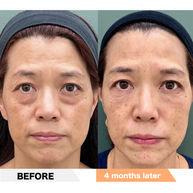

Lower eyelid groove under eyes, PRPF injection therapy
Name of procedure PRPF Therapy Age 30s:Female Procedure Details PRPF is injected subcutaneously with an ultrafine needle into the skin by...


Sunken eye, PRPF injection therapy
Name of procedure PRPF Therapy Age 40s:Female Procedure Details PRPF injected subcutaneously Risks and Side Effects Ecchymosis, swelling...


Lower eyelid groove under eyes, Smile lines, PRPF injection therapy
Name of procedure PRPF Therapy Age 50s:Female Procedure Details PRPF 6.6cc injected subcutaneously Risks and Side Effects Subcutaneous...


Lower eyelid groove under eyes, PRPF injection therapy
Name of procedure PRPF Therapy Age 50s:Male Procedure Details PRPF is injected subcutaneously with an ultrafine needle into the skin by...


Lower eyelid groove under eyes, PRPF injection therapy
Name of procedure PRPF Therapy Age 50s:Female Procedure Details PRPF 5.5cc injected subcutaneously Risks and Side Effects Subcutaneous...


Forehead, PRPF Injection Therapy
Name of procedure PRPF Injection Therapy Age 40s: Female Risks and Side Effects Subcutaneous bleeding spots, swelling Downtime Approx 1...


Forehead, PRPF Injection Therapy
Name of procedure PRPF Injection Therapy Age 50s: Female Risks and Side Effects Subcutaneous bleeding spots, swelling Downtime Approx 1...


Scar PRPF Injection Therapy
This patient has a shallow depressed scar caused by an abrasion. She had already undergone fractional laser several times and came to our...


Lower eyelid groove + laugh lines PRPF Injection Therapy
Name of procedure PRPF Injection Therapy Age 50s: Female Risks and Side Effects Subcutaneous bleeding spots, swelling, redness Downtime...


Forehead, PRPF Injection Therapy
Name of procedure PRPF Injection Therapy Age 70s: Female Risks and Side Effects Subcutaneous bleeding spots, swelling Downtime Approx 1...
